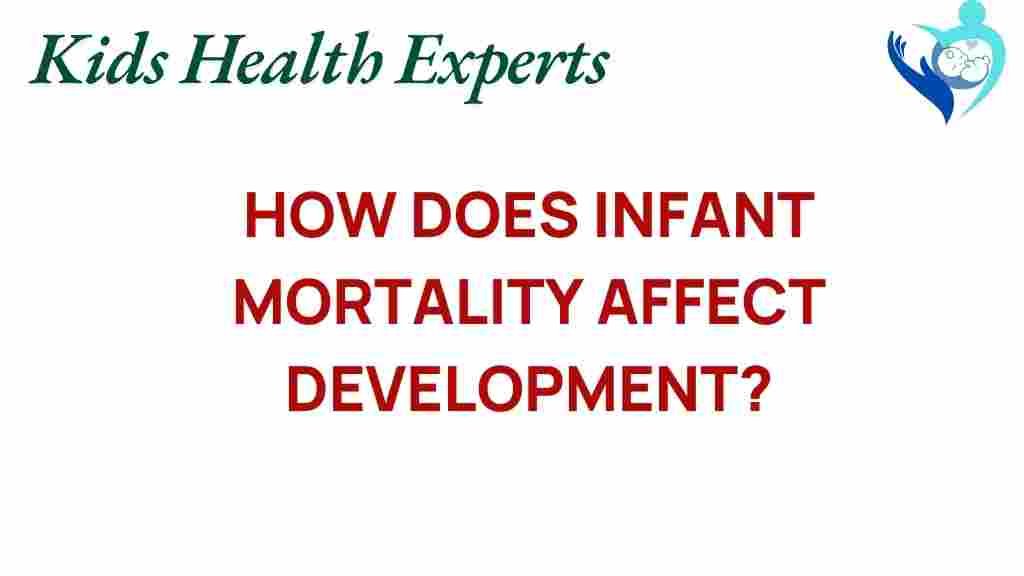Unraveling the Impact of Infant Mortality on Developmental Trajectories
Infant mortality remains a critical public health issue that significantly influences child development and health outcomes. The loss of a child during infancy is not just a personal tragedy; it has profound implications for families, communities, and societies at large. Understanding the factors surrounding infant mortality is essential for developing effective interventions aimed at improving health outcomes in early life. This article explores the intricate relationship between infant mortality, child development, socioeconomic factors, and public health initiatives, providing a comprehensive overview of these concerning issues.
Understanding Infant Mortality
Infant mortality refers to the death of an infant before their first birthday. It is a key indicator of population health and reflects the overall well-being of a society. High rates of infant mortality can signify deeper issues related to healthcare access, maternal health, and socioeconomic disparities. The World Health Organization (WHO) defines infant mortality as a crucial measure, as it encompasses a range of health determinants, including:
- Prenatal care access
- Maternal health during pregnancy
- Socioeconomic status
- Public health policies
- Education and health literacy
The Link Between Infant Mortality and Child Development
Child development is a multifaceted process influenced by various factors, including biological, environmental, and social elements. Infant mortality disrupts this process in numerous ways. Here are some of the most notable impacts:
- Psychological Trauma: The death of an infant can lead to severe emotional and psychological distress for parents and siblings, affecting their ability to nurture surviving children.
- Economic Strain: Families that experience infant loss may face increased financial burdens, leading to reduced resources for remaining children, which can hinder their development.
- Social Disruption: Communities with high infant mortality rates often experience social fragmentation, affecting the support systems that are crucial for healthy child development.
Socioeconomic Factors Influencing Infant Mortality
Socioeconomic factors play a significant role in determining health outcomes and can heavily influence rates of infant mortality. These factors include:
- Income Level: Families with lower incomes are less likely to afford quality healthcare, leading to higher infant mortality rates.
- Education: Maternal education is linked to better health practices during pregnancy and after birth, affecting infant survival rates.
- Access to Healthcare: Geographic and financial barriers can limit access to essential prenatal and postnatal care.
- Nutrition: Poor nutritional status of mothers can lead to low birth weight and associated health risks for infants.
The Role of Public Health in Reducing Infant Mortality
Public health initiatives are crucial in addressing the root causes of infant mortality and improving health outcomes. Effective public health strategies include:
- Improving Maternal Health: Focusing on preconception and prenatal care to ensure mothers are healthy before and during pregnancy.
- Education and Awareness: Programs aimed at educating parents about infant care, breastfeeding, and nutrition can significantly impact survival rates.
- Access to Healthcare: Expanding healthcare access through community clinics and mobile health units, especially in underserved areas.
- Policy Advocacy: Implementing policies that support social determinants of health, such as housing, education, and employment opportunities.
Education as a Tool for Change
Education is a powerful tool in combating infant mortality. By improving educational outcomes for parents, particularly mothers, we can enhance child health and development. Here’s how education contributes:
- Informed Choices: Educated parents are more likely to make informed health choices regarding prenatal care, nutrition, and infant care.
- Empowerment: Education empowers women, leading to better health practices and decision-making capabilities.
- Community Engagement: Educated individuals are often more engaged in their communities, advocating for improvements in healthcare and social services.
Effective Interventions to Address Infant Mortality
To combat the issue of infant mortality and its impact on child development, targeted interventions are necessary. Some effective strategies include:
- Home Visiting Programs: Trained professionals visit families to provide education and support, helping to identify potential risks and improve infant care.
- Nutrition Programs: Initiatives that provide nutritional support to pregnant women and new mothers can lead to healthier pregnancies and better infant outcomes.
- Access to Family Planning: Ensuring families have access to family planning services can help in spacing pregnancies and improving maternal health.
- Community Health Workshops: Organizing workshops that educate about infant care, health screenings, and available resources can empower families.
Troubleshooting Common Issues in Interventions
Implementing interventions effectively can sometimes face challenges. Here are some common issues and suggested solutions:
- Lack of Participation: Families may not engage with programs due to mistrust or lack of awareness. Building trust through community leaders and testimonials can help.
- Resource Limitations: Insufficient resources can hinder program effectiveness. Advocating for funding and partnerships with local organizations can mitigate this.
- Cultural Barriers: Cultural beliefs may conflict with healthcare practices. Tailoring interventions to respect cultural perspectives is essential for success.
Conclusion
Infant mortality is a significant public health challenge that affects child development and health outcomes across the globe. By understanding the socioeconomic factors, the role of education, and the importance of targeted public health interventions, we can begin to unravel the complexities surrounding this issue. Through collaborative efforts that prioritize maternal and child health, we can work towards reducing infant mortality rates and fostering healthier developmental trajectories for future generations.
For further reading on public health strategies and interventions, visit WHO Child Health. To explore local resources and community programs, check out this link.
This article is in the category Conditions and created by KidsHealthExperts Team
